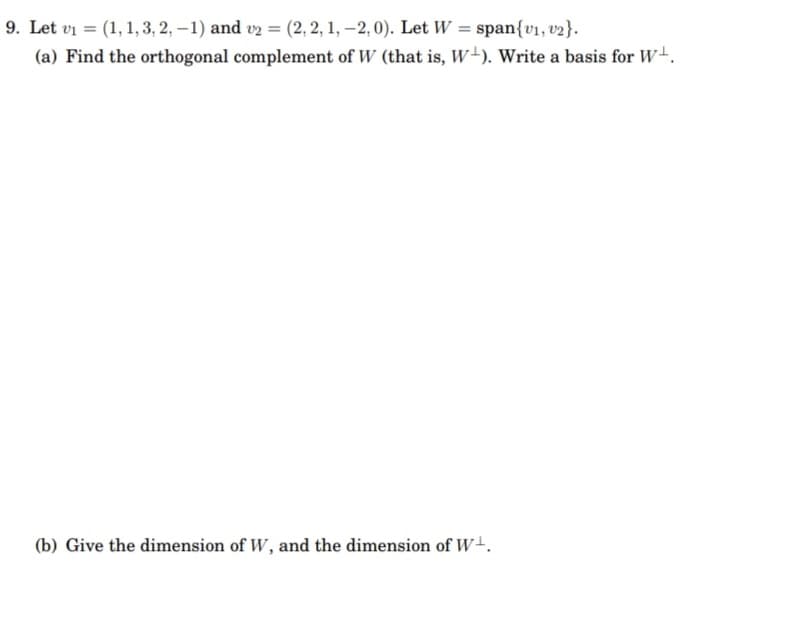9. Let vi = (1, 1, 3, 2, -1) and v2 = (2, 2, 1, -2, 0). Let W = span{v1, v2}. %3D (a) Find the orthogonal complement of W (that is, w+). Write a basis for W+. (b) Give the dimension of W, and the dimension of W+.
9. Let vi = (1, 1, 3, 2, -1) and v2 = (2, 2, 1, -2, 0). Let W = span{v1, v2}. %3D (a) Find the orthogonal complement of W (that is, w+). Write a basis for W+. (b) Give the dimension of W, and the dimension of W+.
Linear Algebra: A Modern Introduction
4th Edition
ISBN:9781285463247
Author:David Poole
Publisher:David Poole
Chapter5: Orthogonality
Section5.2: Orthogonal Complements And Orthogonal Projections
Problem 5EQ
Related questions
Concept explainers
Equations and Inequations
Equations and inequalities describe the relationship between two mathematical expressions.
Linear Functions
A linear function can just be a constant, or it can be the constant multiplied with the variable like x or y. If the variables are of the form, x2, x1/2 or y2 it is not linear. The exponent over the variables should always be 1.
Question
please send solution for part a
only handwritten solution accepted

Transcribed Image Text:9. Let vi = (1, 1,3, 2, –1) and v2 = (2,2, 1, –2, 0). Let W = span{v1, v2}.
%3D
(a) Find the orthogonal complement of W (that is, W+). Write a basis for W.
(b) Give the dimension of W, and the dimension of W+.
Expert Solution
This question has been solved!
Explore an expertly crafted, step-by-step solution for a thorough understanding of key concepts.
Step by step
Solved in 3 steps with 2 images

Knowledge Booster
Learn more about
Need a deep-dive on the concept behind this application? Look no further. Learn more about this topic, advanced-math and related others by exploring similar questions and additional content below.Recommended textbooks for you

Linear Algebra: A Modern Introduction
Algebra
ISBN:
9781285463247
Author:
David Poole
Publisher:
Cengage Learning

Elementary Linear Algebra (MindTap Course List)
Algebra
ISBN:
9781305658004
Author:
Ron Larson
Publisher:
Cengage Learning

Linear Algebra: A Modern Introduction
Algebra
ISBN:
9781285463247
Author:
David Poole
Publisher:
Cengage Learning

Elementary Linear Algebra (MindTap Course List)
Algebra
ISBN:
9781305658004
Author:
Ron Larson
Publisher:
Cengage Learning